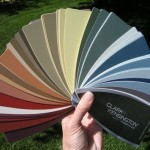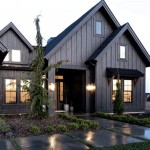What's a Good Color to Paint the Inside of Garage Doors?
Selecting the right color for the interior side of garage doors is a decision often overlooked during home improvement projects. While the exterior color typically receives more attention due to its impact on curb appeal, the interior color plays a significant role in the garage's overall aesthetic and functionality. Color choice influences how the space feels, affects the perceived brightness, and can even impact the garage's usability as a workspace or storage area. Therefore, careful consideration should be given to the options available before committing to a specific shade.
The optimal color will depend on various factors, including the existing interior decor of the garage, the intended use of the space, the amount of natural light available, and personal preferences. Neutral colors generally tend to be popular for their versatility and ability to complement a wide range of styles. However, bolder colors can also be incorporated to create a more dynamic and personalized space. Ultimately, the best color is one that enhances the garage's functionality while aligning with the homeowner's aesthetic vision.
Understanding the Impact of Color Psychology
Color psychology explores the emotional and psychological effects of different colors on human perception and behavior. While individual responses to color can vary, certain colors are generally associated with particular feelings and moods. Understanding these associations can be valuable when selecting a color for the interior of garage doors. For instance, brighter colors like white or light gray can create a sense of spaciousness and cleanliness, while darker colors may evoke feelings of warmth or sophistication. Considering these psychological impacts can help to create a garage environment that is both functional and aesthetically pleasing.
White is often associated with cleanliness, purity, and simplicity. It is a popular choice for garages as it reflects light effectively, making the space appear brighter and more open. This can be particularly beneficial in garages with limited natural light. However, white can also show dirt and stains more easily, requiring more frequent cleaning and maintenance. Light gray offers a similar brightening effect while being slightly more forgiving in terms of hiding grime. It provides a neutral backdrop that complements a variety of decor styles.
Blues and greens are often associated with calmness and tranquility. Lighter shades of blue can create a relaxing and airy atmosphere, while greens can bring a sense of nature and freshness to the space. These colors can be particularly suitable for garages that are used as workshops or hobby areas, as they can help to reduce stress and promote focus. However, it's important to consider the specific shade as some darker blues and greens can make the space feel smaller and more enclosed.
Warmer colors like yellows and oranges are associated with energy, optimism, and creativity. These colors can be used to create a more vibrant and stimulating environment. However, it's generally advisable to use these colors sparingly, as they can be overwhelming if overused. A lighter shade of yellow or orange can be used as an accent color on the garage doors to add a touch of warmth and personality without dominating the space. Red, another warm color, is associated with energy and passion, but is generally avoided in large quantities due to its intensity.
Neutral tones like beige, tan, and cream offer a versatile and understated option for garage doors. These colors blend seamlessly with a variety of interior and exterior styles and provide a warm and inviting feel. They are also more effective at concealing dirt and scratches than brighter colors. These colors are particularly suitable for garages that are used for storage, as they create a clean and organized backdrop that doesn't distract from the items being stored.
Considering the Existing Garage Interior and Exterior
The color of the interior garage doors should complement the existing color scheme of both the interior and exterior of the house. A cohesive color palette can create a more visually appealing and harmonious transition between the garage and the rest of the home. When choosing a color, consider the colors of the walls, flooring, storage systems, and other prominent features in the garage. If the garage is attached to the house, also consider the exterior color of the house and the surrounding landscape. The aim is to create a unified look that enhances the overall aesthetic of the property.
If the garage walls are already painted, the color of the garage doors should harmonize with the wall color. For example, if the walls are a light gray, the garage doors could be painted a slightly darker shade of gray or a complementary neutral color like white or beige. If the walls are a brighter color, such as blue or green, the garage doors could be painted a lighter shade of the same color or a neutral color that complements the wall color. Avoid choosing colors that clash or compete with each other, as this can create a jarring and unpleasant visual effect.
The exterior color of the house should also be taken into consideration, especially if the garage doors are visible from the street. The interior color of the garage doors should complement or contrast with the exterior color in a way that is aesthetically pleasing. For example, if the house is painted a neutral color like beige or gray, the garage doors could be painted a similar neutral color or a contrasting accent color like dark brown or black. If the house is painted a bolder color, the garage doors could be painted a lighter shade of the same color or a neutral color that complements the house color.
Consider the style of the house when choosing a color for the garage doors. For example, a traditional-style house might benefit from a classic color like white, cream, or light gray, while a modern-style house might be better suited to a bolder color like dark gray, black, or blue. The goal is to choose a color that enhances the architectural style of the house and contributes to its overall curb appeal.
Prioritizing Functionality and Practicality
Beyond aesthetics, practical considerations should also factor into the color selection process. The primary function of a garage is to provide a safe and secure space for parking vehicles and storing belongings. Therefore, the color of the garage doors should not compromise the functionality of the space or create safety hazards. For example, dark colors can make it difficult to see in poorly lit garages, which can increase the risk of accidents. Similarly, overly bright colors can be distracting and make it difficult to focus on tasks being performed in the garage.
Consider the amount of natural light that enters the garage. If the garage has limited natural light, it's generally advisable to choose a light color for the garage doors to maximize brightness and visibility. White, light gray, and light beige are all excellent options for brightening up a dark garage. If the garage has ample natural light, darker colors can be used without making the space feel too enclosed or gloomy. However, it's important to avoid extremely dark colors like black or deep brown, as these can absorb heat and make the garage uncomfortably warm in the summer.
The durability and maintenance requirements of the paint color should also be considered. Darker colors tend to show scratches and dents more easily than lighter colors. They also tend to fade more quickly when exposed to sunlight. Therefore, if durability and low maintenance are important, it's generally advisable to choose a lighter color for the garage doors. Consider the type of paint being used as well. High-quality paints are more resistant to fading, chipping, and peeling, and they are also easier to clean. Choose a paint that is specifically designed for use on garage doors and that is resistant to moisture and temperature fluctuations.
Finally, consider the intended use of the garage. If the garage is primarily used for parking vehicles and storing belongings, a neutral color like white, gray, or beige may be the most practical choice. These colors are versatile, easy to clean, and don't distract from the primary function of the space. If the garage is used as a workshop or hobby area, a lighter color like blue or green may be more suitable, as these colors can promote focus and reduce stress. If the garage is used as a living space, such as a home gym or game room, a warmer color like yellow or orange may be used to create a more inviting and stimulating environment. However, it's important to balance aesthetics with practicality to ensure that the garage remains a functional and comfortable space.

5 Simple Guidelines For Choosing Garage Paint Colors

Choosing Interior Garage Paint Colors Wow 1 Day Painting

Choosing Interior Garage Paint Colors Wow 1 Day Painting

5 Simple Guidelines For Choosing Garage Paint Colors

Choosing Interior Garage Paint Colors Wow 1 Day Painting

5 Simple Guidelines For Choosing Garage Paint Colors

Garage Paint Ideas Colors For The Floor Door Walls

Garage Paint Ideas Colors For The Floor Door Walls

Best Color For Garage Walls 12 Ideas Paint Schemes

The 7 Best Colors To Paint Your Garage Door
Related Posts








